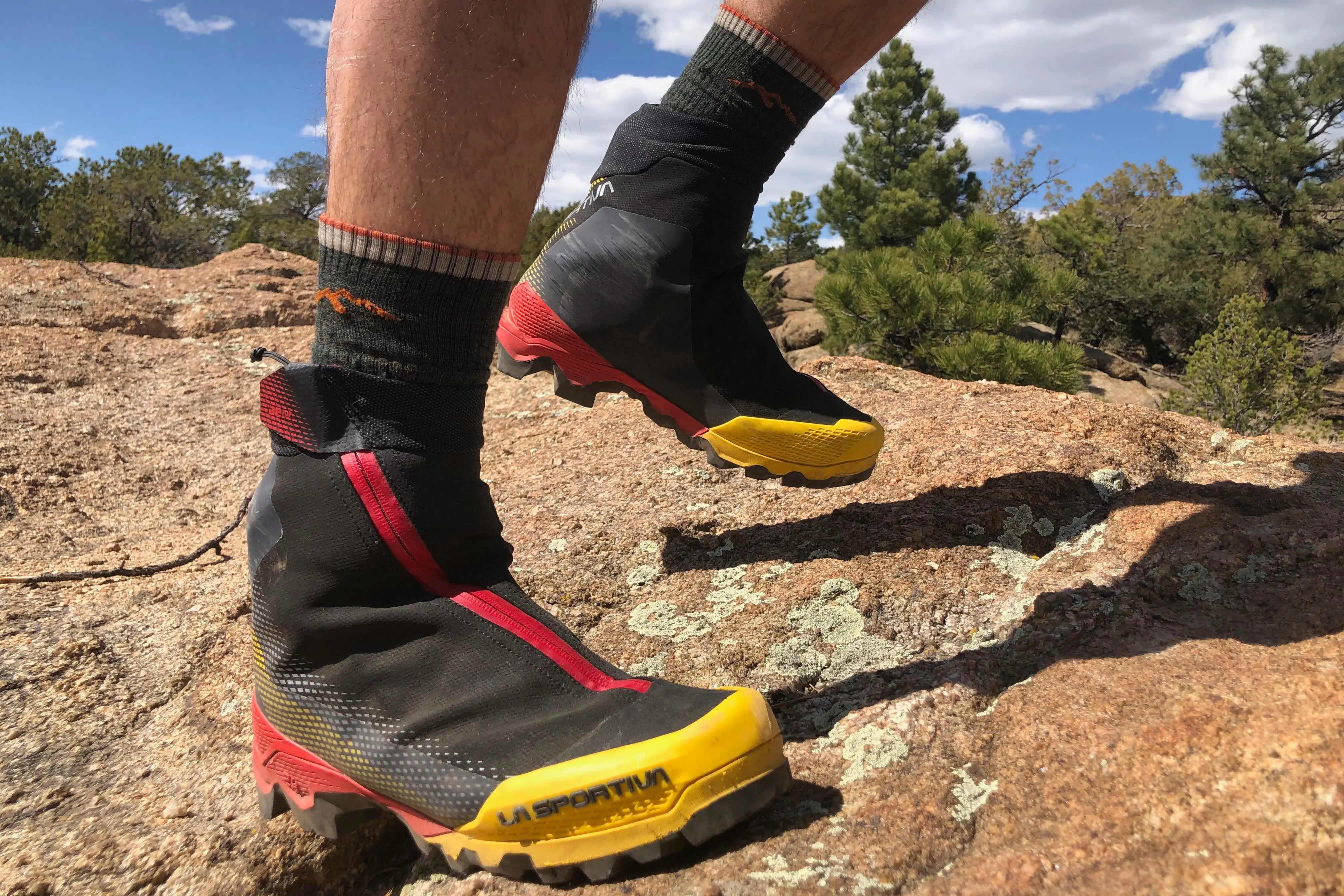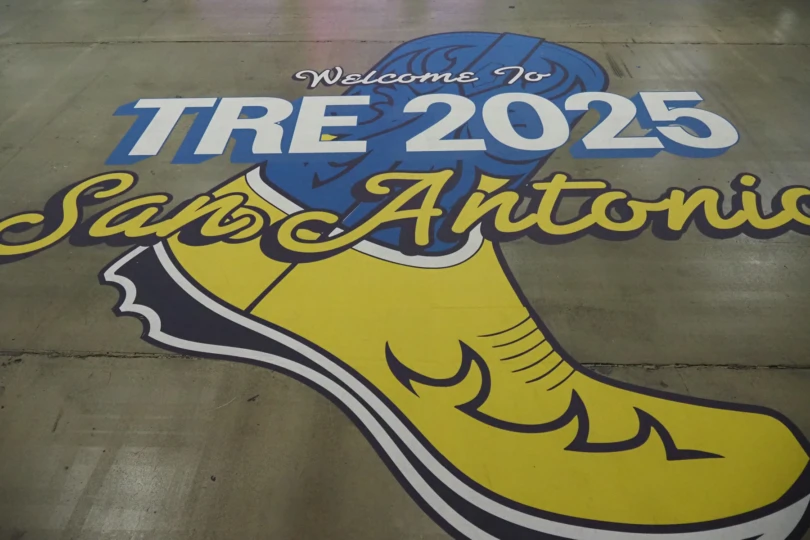Our headlamp beams reflected off the dirty white snow, and my heart sank. Late-season snow drifts were blocking what we thought would be a snow-free approach to our ridge scramble peak ascent. That meant a lot of post-holing on the way out once the snow softened. An issue to deal with later, in the now much-longer day.
I was sporting the new La Sportiva Aequilibrium Top GTX boots and felt confident that a few hours of post-holing wouldn’t ruin my day of ridge scrambling. I was mostly right.
For about three-quarters of the year in the high mountains of Colorado, we’re graced with feet on feet of snow basically everywhere, especially above treeline. If you’re looking to scramble, climb, or hike in the high mountains, that often means bringing multiple pairs of footwear to deal with the post-holing. That, or turning around early. Or worse yet, staying home altogether.
As I write this, AI hiking bears are loose in the wild; some smartwatches have infinite battery life. Why, then, are we still stuck with boot gaiters that haven’t improved or changed since the 1800s? I’ve been gravitating towards a new generation of boots and shoes with integrated gaiters, like the Aequilibrium Top GTX, for shoulder season mountain activities.
In short: Integrated gaiters are the greatest thing to happen to boot gaiters in at least a century. One model in La Sportiva’s new Aequilibrium three-season mountaineering boot line, the Aequilibrium Top GTX, adds a gaiter to widen the boot’s seasonality and versatility for wet conditions. The boot’s innovative rocker profile, comfort, and superb walkability make it a favorite for hikers, backpackers, and mountaineers needing a boot to handle less-than-ideal conditions.
- Weight: 650 g per boot
- Upper material: Stretch Honey-Comb Guard, TPU mudguard shield, TPU heel and toecaps
- Insulation: None
- Lining: GORE-TEX Performance Comfort
- Closure (inner boot): Differentiated lacing with BOA closure system
- Closure (lace cover): Zipper
- Last: Aequilibrium, medium
Pros
- Lightweight mountaineering boot that can be used for backpacking
- GORE-TEX lining is totally waterproof and breathable
- Accommodates hybrid crampons
- Comfortable out of the box
Cons
- The gaiter seal at the top isn't perfect
- No gaiter hook
La Sportiva Aequilibrium Top GTX Review
Footwear is one of the most important gear decisions that you make before heading into the backcountry, especially during shoulder seasons or for complicated overland routes where you’ll encounter rock, snow, and ice. The La Sportiva Aequilibrium line says “no more” to the old way of bringing a trail runner for the approach, plus a mountaineering boot strapped to your backpack.
Walkability
I assumed the new Aequilibrium line would walk like an upgraded Trango, La Sportiva’s long-standing three-season mountaineering boot. The Trango’s three-quarter shank makes them very stiff. It felt like it took three years to break them in.
That wasn’t the case with the Aequilibriums. They are on the other end of the mountaineering boot softness spectrum. They’re closer to a stiff hiking boot than a full-shank mountaineering boot.
That means they walk comfortably. Because they move and flex naturally with my foot, I suffered from far fewer blisters than with my Trangos. And by far fewer, I mean zero. I have yet to get a blister in these boots. The break-in period barely felt like one. I could walk around with these all day, with or without a pack, and my feet were happy, more or less.
The sole contributes significantly to the walkability as well. The deep lugs of the Vibram SpringLug Tech rubber are heavily rockered, including in the heel, to make your strides feel more natural than is normal from a technical boot.
Softer also means faster. You can move much more quickly with Aequilibriums on your feet than with other three-season mountaineering boots. That, paired with a relatively scant 650g weight, gave them get-up-and-go energy. For comparison, the Scarpa Ribelle Run Kalibra G that I reviewed earlier this year, a winter trail runner inspired by three-season mountaineering boots, weighs 368g. The longstanding La Sportiva Trango Tower GTX weighs in at 745g.
Donning the Aequilibriums is less complicated than it looks. Unzip the gaiter, open the velcro strap, pop open the BOA dial, and slip your foot in. Tighten it all up for a comfortable out-of-the-box fit. A really comfortable fit, honestly. That’s what has stuck out to me the most with these boots. My foot shape is a nightmare — ultra high arches and hammer toes, meaning I’m usually doing a lot of modification to get the right fit. Not the case here. I haven’t even felt the need to add a custom footbed yet.
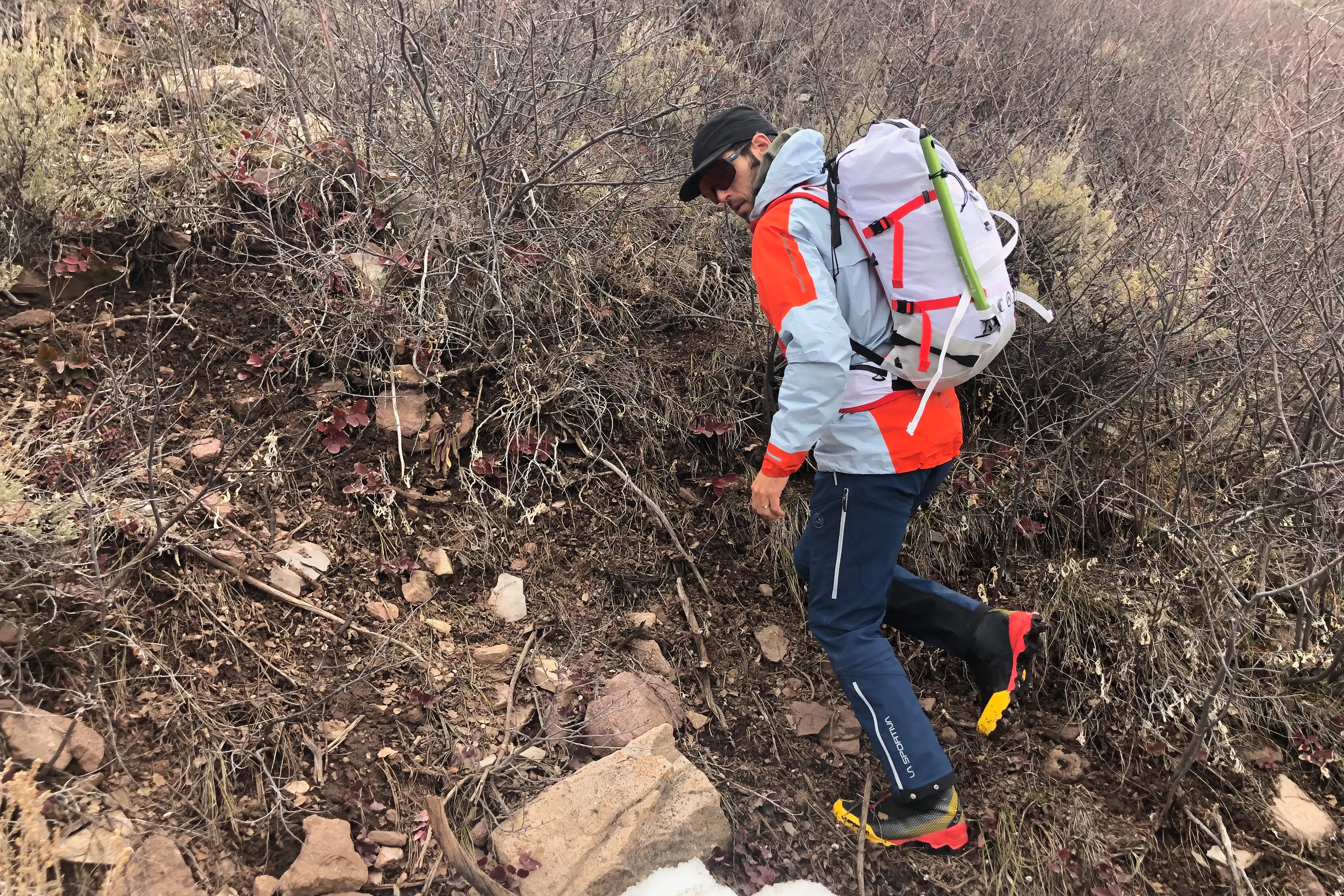
Climbing
Two factors led me to believe that the Aequilibriums wouldn’t climb as well as my trusty Trango’s: the softness and the deeply lugged tread.
While much softer than the Trango’s, they still have plenty of stiffness and torsional rigidity to edge confidently. I found that they could utilize relatively small holds in a fairly confident manner, and they stuff into bigger cracks nicely. On the flip side, the softness lends itself well to smearing, where the boots surprisingly excel despite the relatively firm deep-soled rubber of the Vibram Mont.
The Aequilibriums don’t climb or scramble like approach shoes. But for a mountain boot, they’re solid.
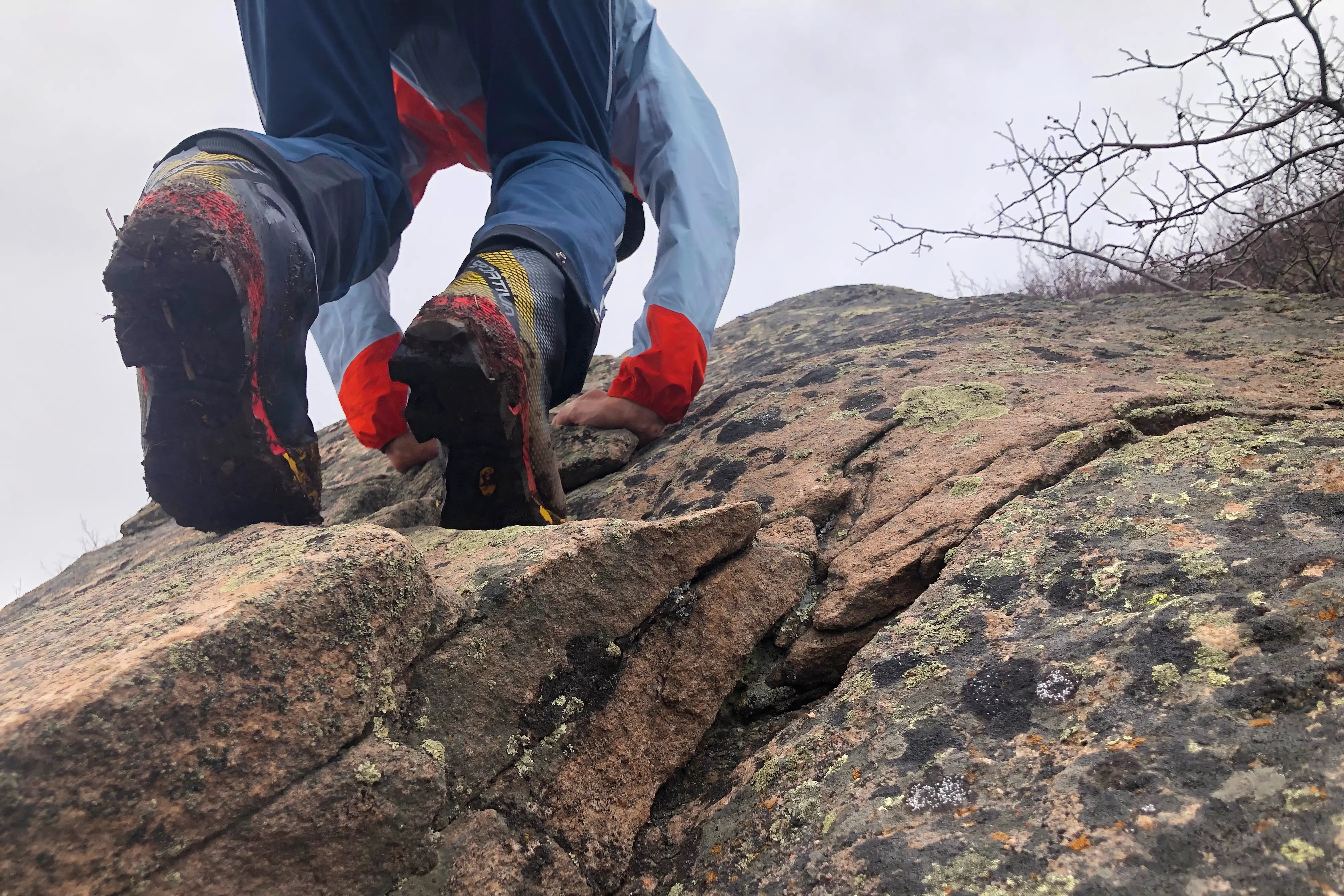



Backpacking
La Sportiva lists “backpacking” as a primary use for the Aequilibriums, and I agree. Given that they walk so much better than other three-season mountaineering boots, they’re great for carrying heavy loads long distances, especially in rugged terrain where you might encounter snow, wet weather, or generally swampy conditions.
I found them to be excellent for shoulder season and late spring backpacking footwear for Colorado, where snow is a guarantee until mid-June. I had no problem hiking all day and then hanging out in them all afternoon, all while enjoying the protection from the wetness outside. And I loved the support that the sole provided under a heavy load, too. It made rocky trails much more enjoyable on the feet.
While they aren’t insulated, they do run fairly warm with the integrated gaiter. I wore these boots on a long hike on a hot day, and my feet definitely got toasty and sweaty. They wouldn’t be my first choice for a hot, dry August backpacking trip. But for early or late-season trips or backpacking in colder regions, they would do the job.
Snow
Mountaineering almost always means crossing or climbing snow in some capacity, and the Aequilibrium Top GTX can meet that need. Full-shank boots like the La Sportiva G-Tech climb firm snow the best. They can kick in and edge without flexing. That comes with major compromises in walkability.
The Aequilibriums trade that stiffness and accompanying technical climbing prowess for comfort and walkability. They just don’t climb hard snow as well. They’re far better than a typical hiking boot, however.
When the terrain does exceed the sole’s capacity, they accommodate semi-automatic crampons thanks to the heel welts. It paired well with my Grivel G12 crampons. You won’t be dry tooling in these boots or climbing steep waterfall ice confidently. But the crampon integration is solid for general mountaineering that doesn’t require a rigid sole.
The gaiter zipper isn’t itself waterproof. But a GORE-TEX Performance Comfort lining underneath the gaiter handles waterproofing duties. I found it to be effective at keeping the water out, as advertised.
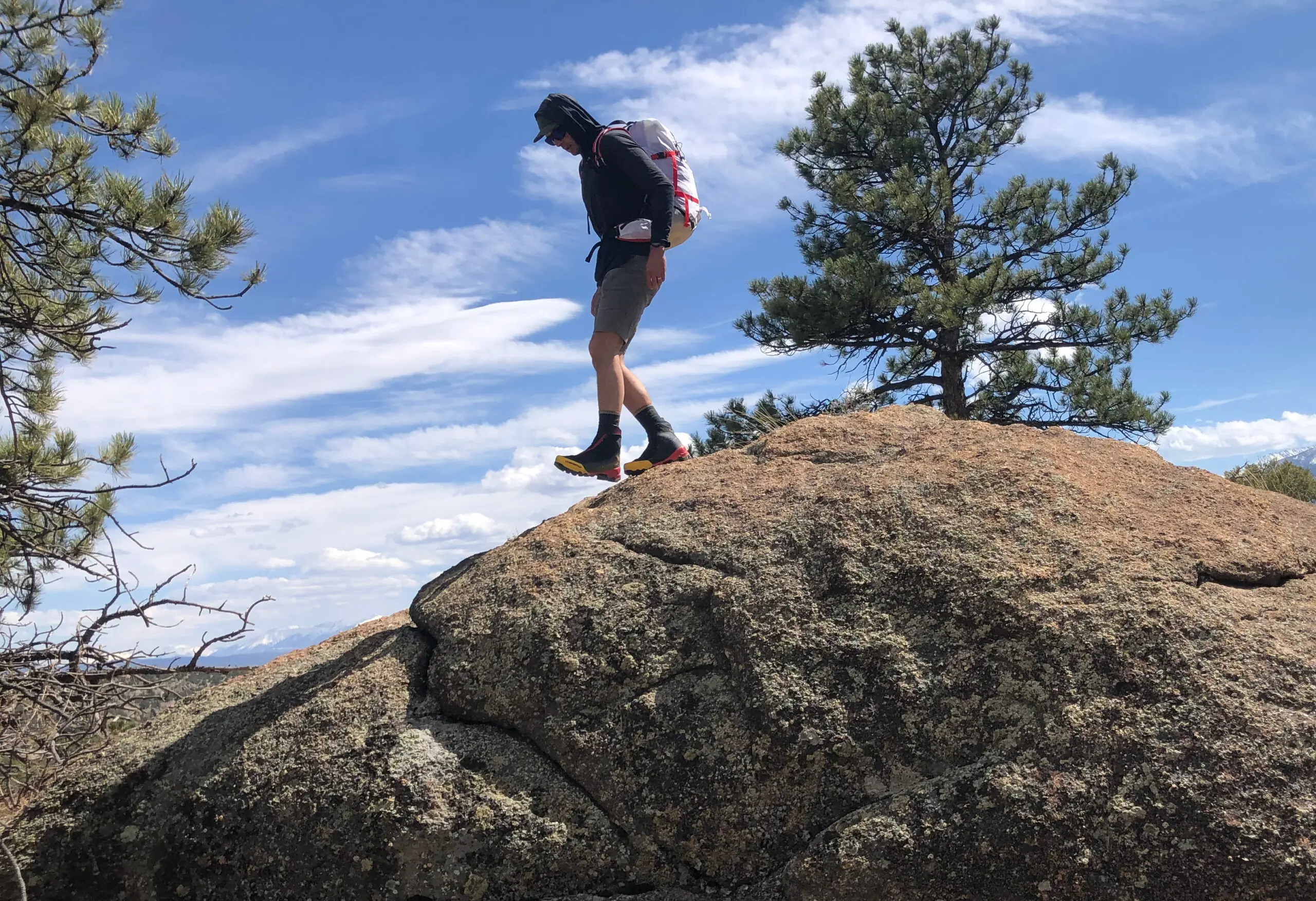



Durability
Durability is always on my mind when I pick up lightweight anything. These aren’t the tried and true leather mountaineering boots of yore. But the Aequilibriums do come in a slightly heavier leather version, the gaiterless, laced, and significantly cheaper Aequilibrium LT GTX.
I’ve been keeping an eye on the zipper, BOA system, and lightweight gaiter in particular. The zipper is lightweight, but it’s still pulling and gliding cleanly. I’ve been careful not to pull too hard since busting the teeth would require a custom fix, and it would be impossible to fix in the field.
Unlike the G-Tech ice climbing boots, the BOA dial is tucked inside the outer gaiter and additionally protected by rubberized rand over the top of the gaiter. The inner cable is the standard durable steel cable, not braided Dyneema, like BOA-equipped running shoes.
The lacing eyelets are reinforced with nylon guides. So I’m not particularly worried about them ripping through the eyelets over time, as I’ve experienced with some BOA footwear. BOAs are inherently more vulnerable than normal laces. But overall, the knobs are integrated about as well as possible for a boot like this.
The gaiter is lightweight and stretchy, with some additional rubberized protection above the outsole package extending about an inch up the pinky toe side of the boot and about six inches over the ankle bone on the big toe side of the boot. The scuff marks on these rubberized panels prove that these patches are critical durability components.
The remainder of the gaiter, however, is exposed. A stray crampon tooth could bite through like an osprey’s talon through a trout. It wouldn’t be difficult to patch, but the bigger concern would be compromising the gaiter’s zipper.
Speculation aside, I haven’t experienced a single durability issue so far. They’re well made, as you’d expect from the Italian boot crafters at La Sportiva.
Room for Improvement
For such an elegantly crafted boot and well-thought-out gaiter, I was surprised when a little bit of snow got in after post-holing through powder snow. The top of the gaiter doesn’t seal around my leg like I thought it might. In some parts of a normal stride, there’s a small gap between my sock and the top of the stretchy gaiter. There’s no way to cinch it down, either, like there is on my La Sportiva G5 Mountaineering boots, which utilize an elastic drawcord at the cuff.
That said, the inner boot and tongue didn’t let the snow get very far because they closed tightly around my ankle.
A gaiter hook loop would be a nice feature on the outside of the boot’s upper. Most of my favorite alpine pants, like the Norrøna Falketind, have a small hook on the cuff that, when attached to a boot’s laces, acts as a simple gaiter for an extra layer of protection.
La Sportiva Aequilibrium Top GTX Conclusion
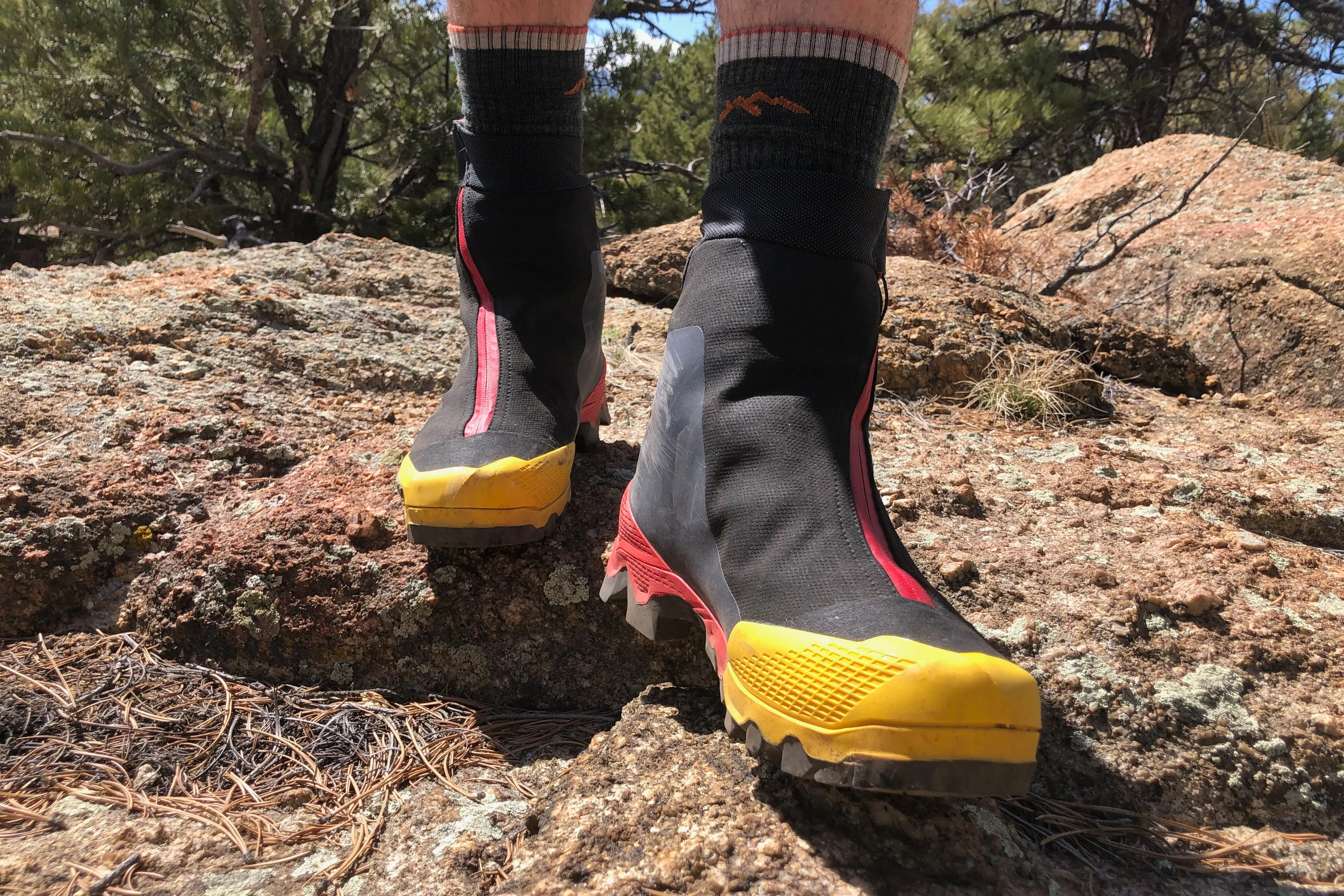



The La Sportiva Aequilibrium Top GTX is an innovative and high-performance boot with a price tag to match. The gaiter isn’t flawless, but the overall boot package is outstanding. It walks and climbs remarkably well, plus it’s comfortable enough for long days in the backcountry.
It’s an excellent boot for long hikes or climbs in rocky terrain where you’re more likely than not to encounter snow drifts and steep snow.
Think spring and late fall fourteener climbing in Colorado — this boot is perfectly matched to that niche. Backpacking in wet conditions? The Aequilibrium Top will keep you dry and happy there too, all without pulling your archaic boot gaiters out of storage.
